inflation pressure Lexus GS350 2010 Do-It-Yourself Maintenance / LEXUS 2010 GS460 GS350 OWNERS MANUAL (OM30C80U)
[x] Cancel search | Manufacturer: LEXUS, Model Year: 2010, Model line: GS350, Model: Lexus GS350 2010Pages: 648, PDF Size: 15.57 MB
Page 5 of 648

1
2
3
4
5
6
7
5
GS_G_U (OM30C80U)
June 29, 2011 10:30 am
4-1. Maintenance and care
Cleaning and protecting
the vehicle exterior.................. 430
Cleaning and protecting
the vehicle interior .................... 433
4-2. Maintenance
Maintenance
requirements............................... 436
General maintenance ............... 438
Emission inspection and
maintenance (I/M)
programs ....................................... 4414-3. Do-it-yourself maintenance
Do-it-yourself service
precautions .................................. 442
Hood ................................................. 445
Positioning a floor jack............... 446
Engine compartment.................. 448
Tires ................................................... 463
Tire inflation pressure................. 473
Wheels ............................................. 477
Air conditioning filter.................. 479
Electronic key battery ................ 482
Checking and replacing
fuses ................................................ 484
Headlight aim ............................... 509
Light bulbs ........................................ 512
5-1. Essential information
Emergency flashers ................... 520
If your vehicle needs
to be towed ................................... 521
If you think something is
wrong ............................................ 530
Fuel pump shut off system ......... 531
Event data recorder.................... 532
4Maintenance and care
5When trouble arises
Page 9 of 648
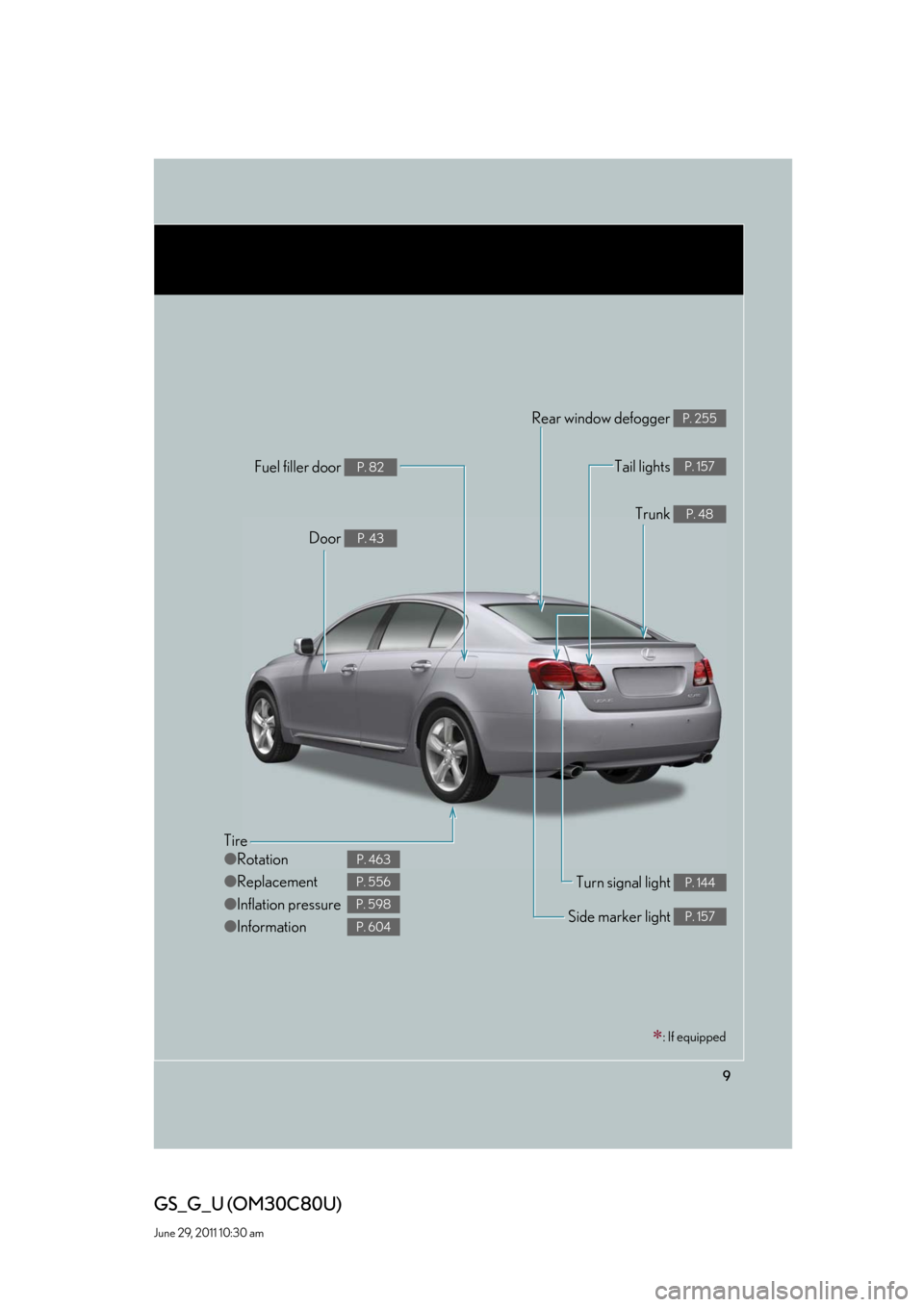
9
GS_G_U (OM30C80U)
June 29, 2011 10:30 am
Tire
●Rotation
●Replacement
●Inflation pressure
●Information
P. 463
P. 556
P. 598
P. 604
Tail lights P. 157
Side marker light P. 157
Trunk P. 48
Rear window defogger P. 255
Door P. 43
Fuel filler door P. 82
Turn signal light P. 144
: If equipped
Page 222 of 648
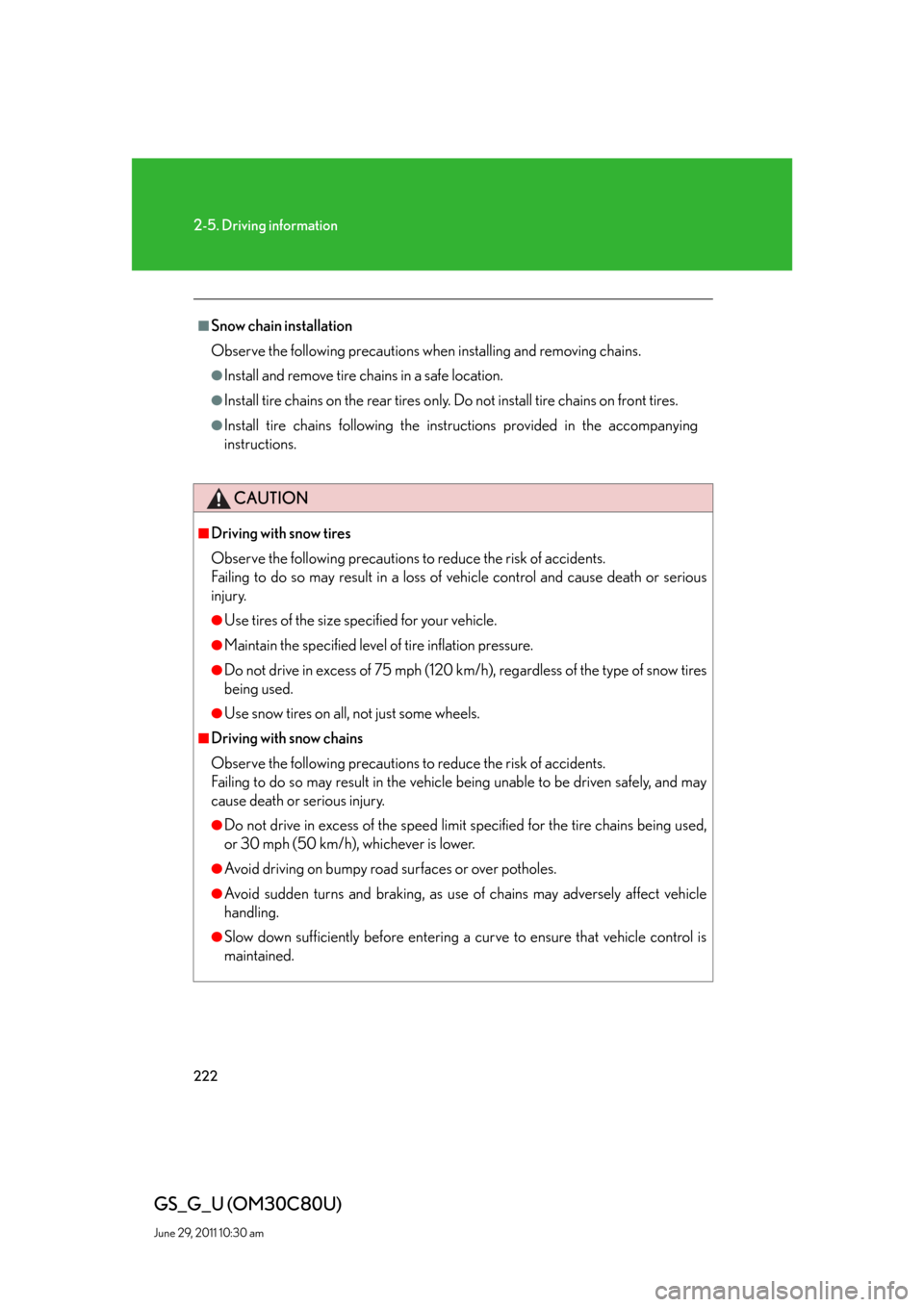
222
2-5. Driving information
GS_G_U (OM30C80U)
June 29, 2011 10:30 am
■Snow chain installation
Observe the following precautions when installing and removing chains.
●Install and remove tire chains in a safe location.
●Install tire chains on the rear tires only. Do not install tire chains on front tires.
●Install tire chains following the instructions provided in the accompanying
instructions.
CAUTION
■Driving with snow tires
Observe the following precautions to reduce the risk of accidents.
Failing to do so may result in a loss of vehicle control and cause death or serious
injury.
●Use tires of the size specified for your vehicle.
●Maintain the specified level of tire inflation pressure.
●Do not drive in excess of 75 mph (120 km/h), regardless of the type of snow tires
being used.
●Use snow tires on all, not just some wheels.
■Driving with snow chains
Observe the following precautions to reduce the risk of accidents.
Failing to do so may result in the vehicle being unable to be driven safely, and may
cause death or serious injury.
●Do not drive in excess of the speed limit specified for the tire chains being used,
or 30 mph (50 km/h), whichever is lower.
●Avoid driving on bumpy road surfaces or over potholes.
●Avoid sudden turns and braking, as use of chains may adversely affect vehicle
handling.
●Slow down sufficiently before entering a curve to ensure that vehicle control is
maintained.
Page 429 of 648
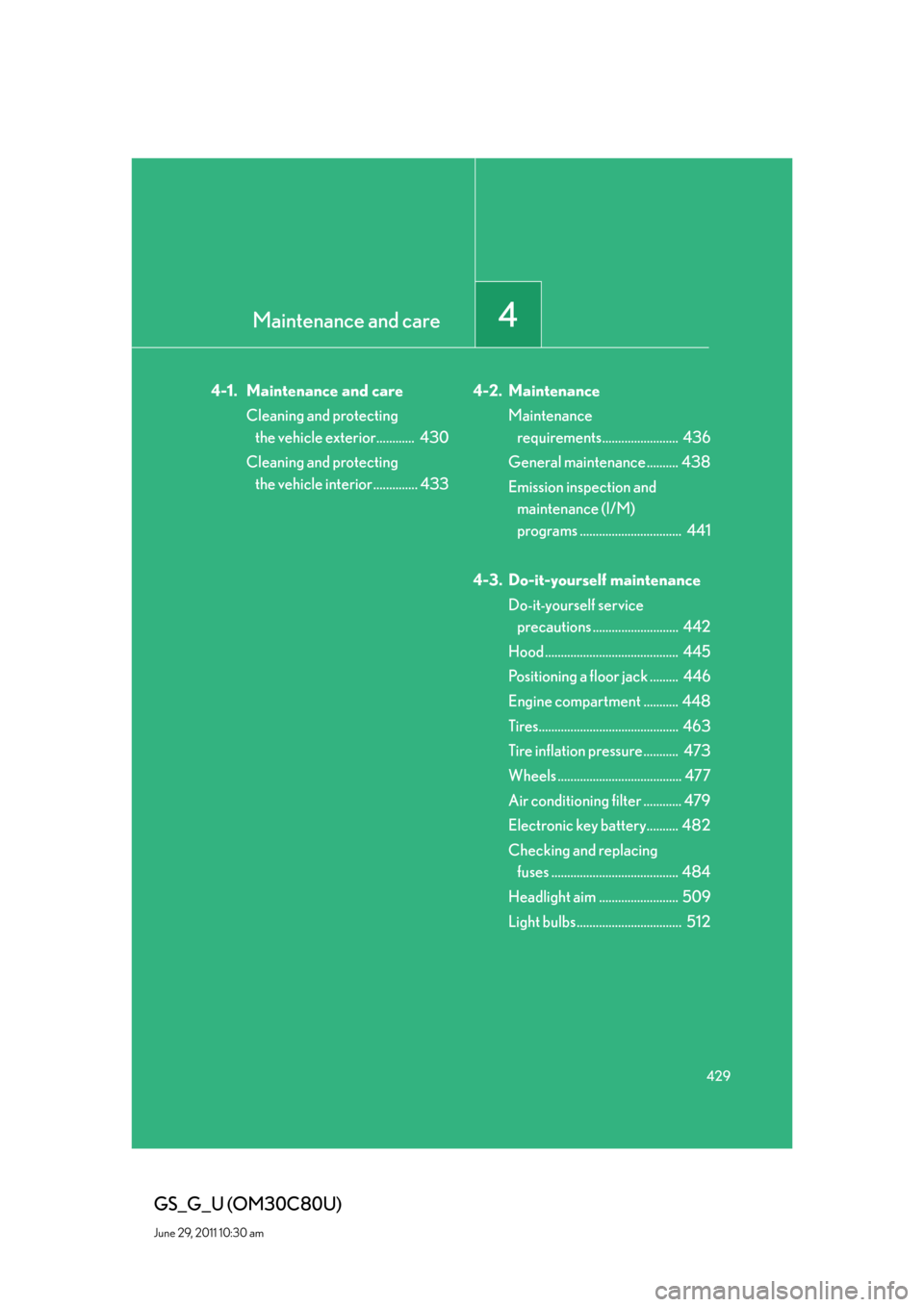
Maintenance and care4
429
GS_G_U (OM30C80U)
June 29, 2011 10:30 am
4-1. Maintenance and care
Cleaning and protecting
the vehicle exterior............ 430
Cleaning and protecting
the vehicle interior .............. 4334-2. Maintenance
Maintenance
requirements........................ 436
General maintenance .......... 438
Emission inspection and
maintenance (I/M)
programs ................................ 441
4-3. Do-it-yourself maintenance
Do-it-yourself service
precautions ........................... 442
Hood .......................................... 445
Positioning a floor jack ......... 446
Engine compartment ........... 448
Tires............................................ 463
Tire inflation pressure........... 473
Wheels ....................................... 477
Air conditioning filter ............ 479
Electronic key battery.......... 482
Checking and replacing
fuses ........................................ 484
Headlight aim ......................... 509
Light bulbs ................................. 512
Page 440 of 648
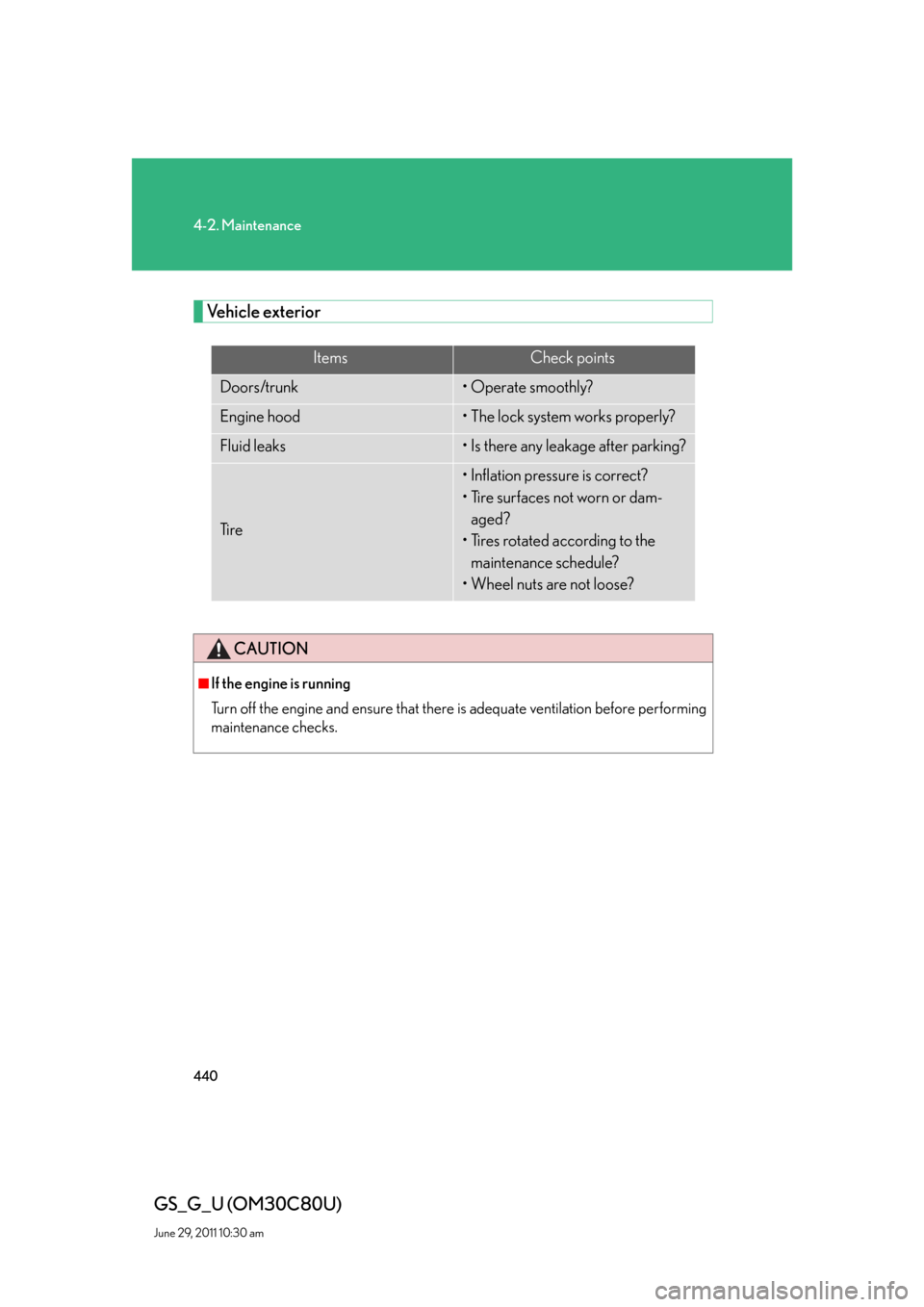
440
4-2. Maintenance
GS_G_U (OM30C80U)
June 29, 2011 10:30 am
Vehicle exterior
ItemsCheck points
Doors/trunk• Operate smoothly?
Engine hood• The lock system works properly?
Fluid leaks• Is there any leakage after parking?
Ti r e
• Inflation pressure is correct?
• Tire surfaces not worn or dam-
aged?
• Tires rotated according to the
maintenance schedule?
• Wheel nuts are not loose?
CAUTION
■If the engine is running
Turn off the engine and ensure that there is adequate ventilation before performing
maintenance checks.
Page 443 of 648
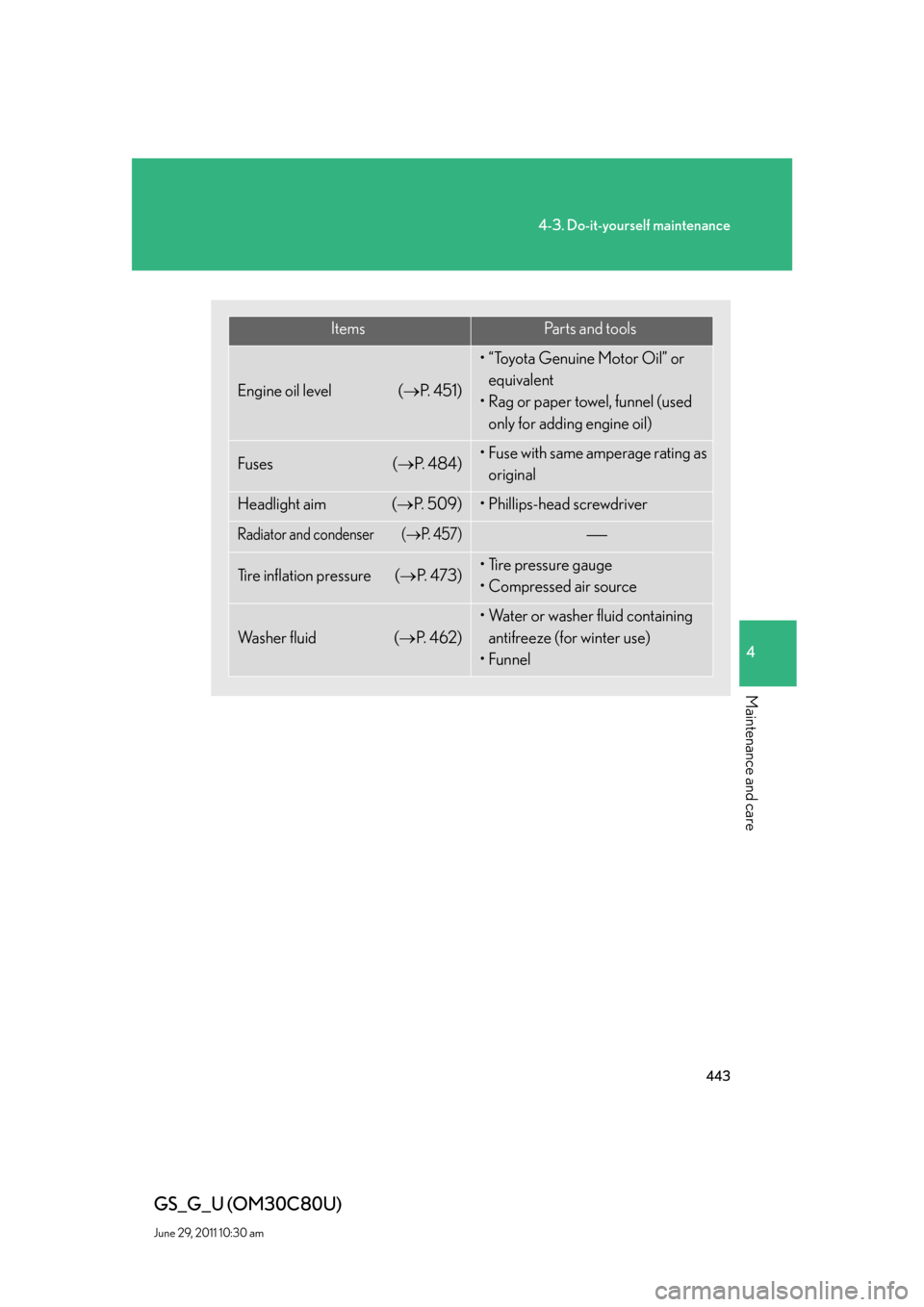
443
4-3. Do-it-yourself maintenance
4
Maintenance and care
GS_G_U (OM30C80U)
June 29, 2011 10:30 am
ItemsPa r t s a n d t o o l s
Engine oil level (P. 4 5 1 )
• “Toyota Genuine Motor Oil” or
equivalent
• Rag or paper towel, funnel (used
only for adding engine oil)
Fuses (P. 484)• Fuse with same amperage rating as
original
Headlight aim (P. 5 0 9 )• Phillips-head screwdriver
Radiator and condenser (P. 4 5 7 )
Tire inflation pressure (P. 4 7 3 )• Tire pressure gauge
• Compressed air source
Wa s h e r f l u i d (P. 4 6 2 )
• Water or washer fluid containing
antifreeze (for winter use)
•Funnel
Page 463 of 648
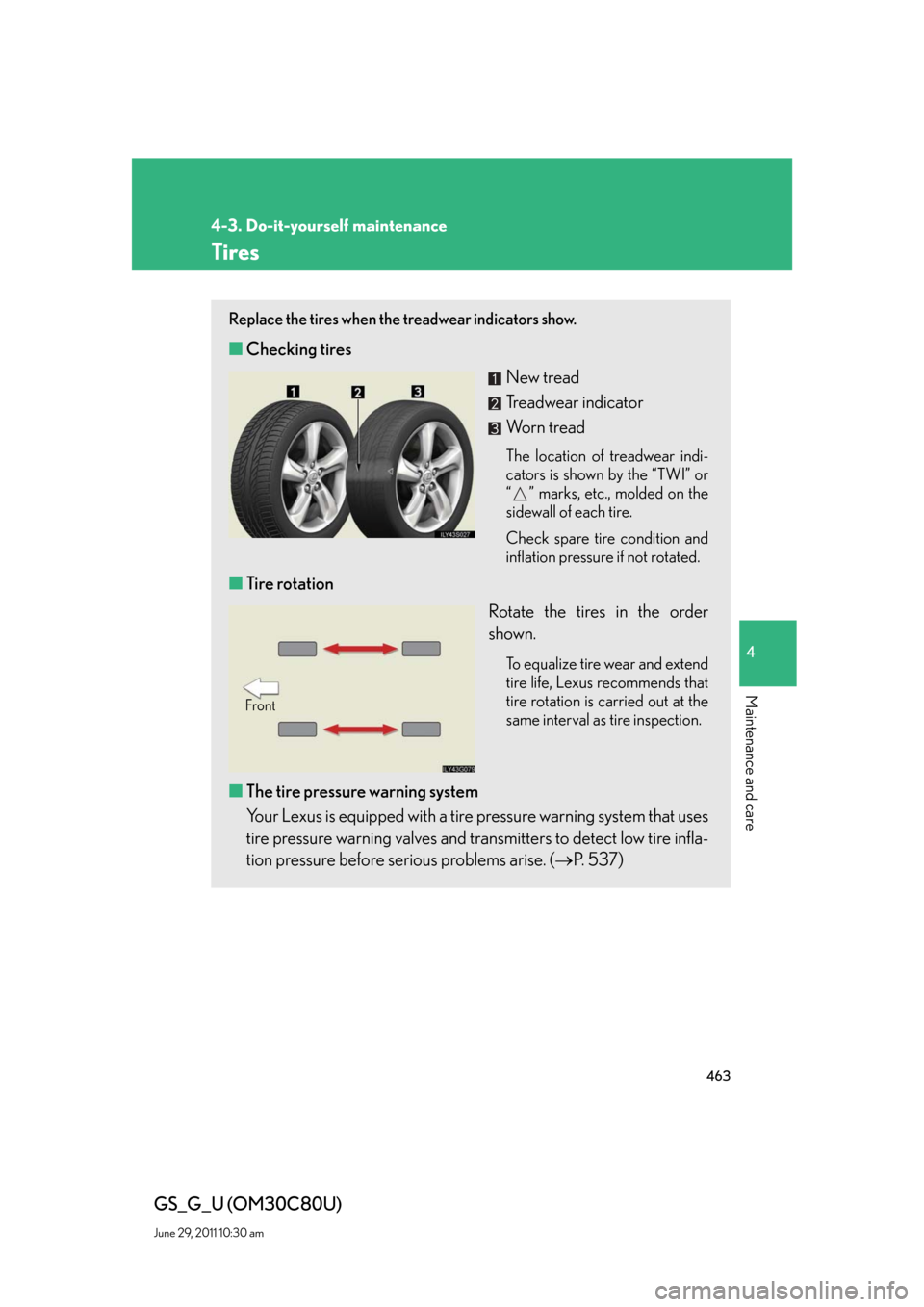
463
4-3. Do-it-yourself maintenance
4
Maintenance and care
GS_G_U (OM30C80U)
June 29, 2011 10:30 am
Tires
Replace the tires when the treadwear indicators show.
■Checking tires
New tread
Treadwear indicator
Worn tread
The location of treadwear indi-
cators is shown by the “TWI” or
“ ” marks, etc., molded on the
sidewall of each tire.
Check spare tire condition and
inflation pressure if not rotated.
■Tire rotation
Rotate the tires in the order
shown.
To equalize tire wear and extend
tire life, Lexus recommends that
tire rotation is carried out at the
same interval as tire inspection.
■The tire pressure warning system
Your Lexus is equipped with a tire pressure warning system that uses
tire pressure warning valves and transmitters to detect low tire infla-
tion pressure before serious problems arise. (P. 5 3 7 )
Front
Page 464 of 648

464
4-3. Do-it-yourself maintenance
GS_G_U (OM30C80U)
June 29, 2011 10:30 am
Installing tire pressure warning valves and transmitters
When replacing tires or wheels, tire pressure warning valves and trans-
mitters must also be installed.
When new tire pressure warning valves and transmitters are installed,
new tire pressure warning valve and transmitter ID codes must be regis-
tered in the tire pressure warning computer and tire pressure warning
system must be initialized. Have tire pressure warning valve and transmit-
ter ID codes registered by your Lexus dealer. (P. 466)
Initializing the tire pressure warning system
■The tire pressure warning system must be initialized in the following
circumstances:
●When changing the tire inflation pressure by changing traveling
speed or load weight, etc.
●When changing the tire size.
When the tire pressure warning system is initialized, the current tire
inflation pressure is set as the pressure benchmark.
Page 465 of 648
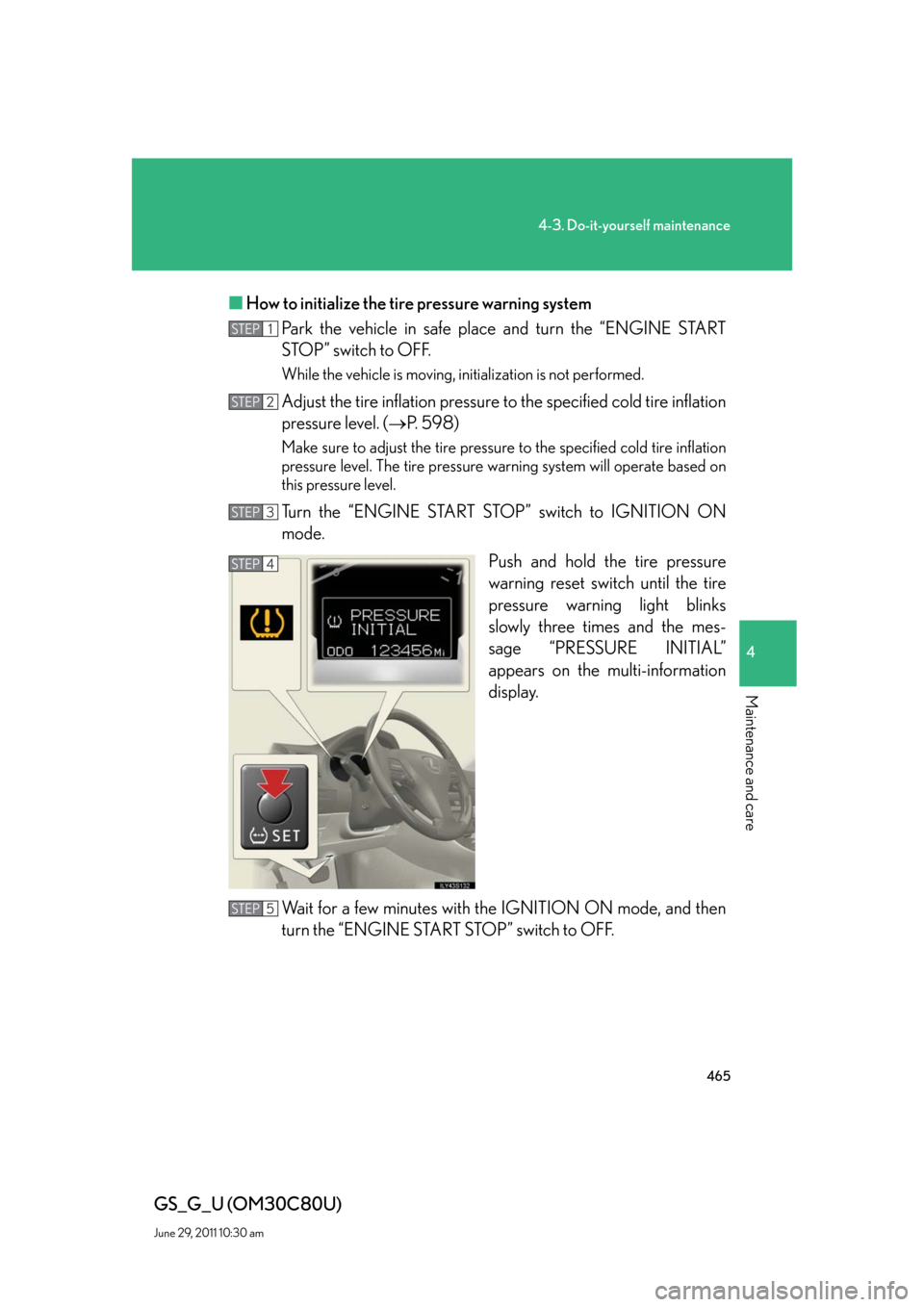
465
4-3. Do-it-yourself maintenance
4
Maintenance and care
GS_G_U (OM30C80U)
June 29, 2011 10:30 am
■How to initialize the tire pressure warning system
Park the vehicle in safe place and turn the “ENGINE START
STOP” switch to OFF.
While the vehicle is moving, initialization is not performed.
Adjust the tire inflation pressure to the specified cold tire inflation
pressure level. (P. 5 9 8 )
Make sure to adjust the tire pressure to the specified cold tire inflation
pressure level. The tire pressure warning system will operate based on
this pressure level.
Turn the “ENGINE START STOP” switch to IGNITION ON
mode.
Push and hold the tire pressure
warning reset switch until the tire
pressure warning light blinks
slowly three times and the mes-
sage “PRESSURE INITIAL”
appears on the multi-information
display.
Wait for a few minutes with the IGNITION ON mode, and then
turn the “ENGINE START STOP” switch to OFF.
STEP1
STEP2
STEP3
STEP4
STEP5
Page 468 of 648
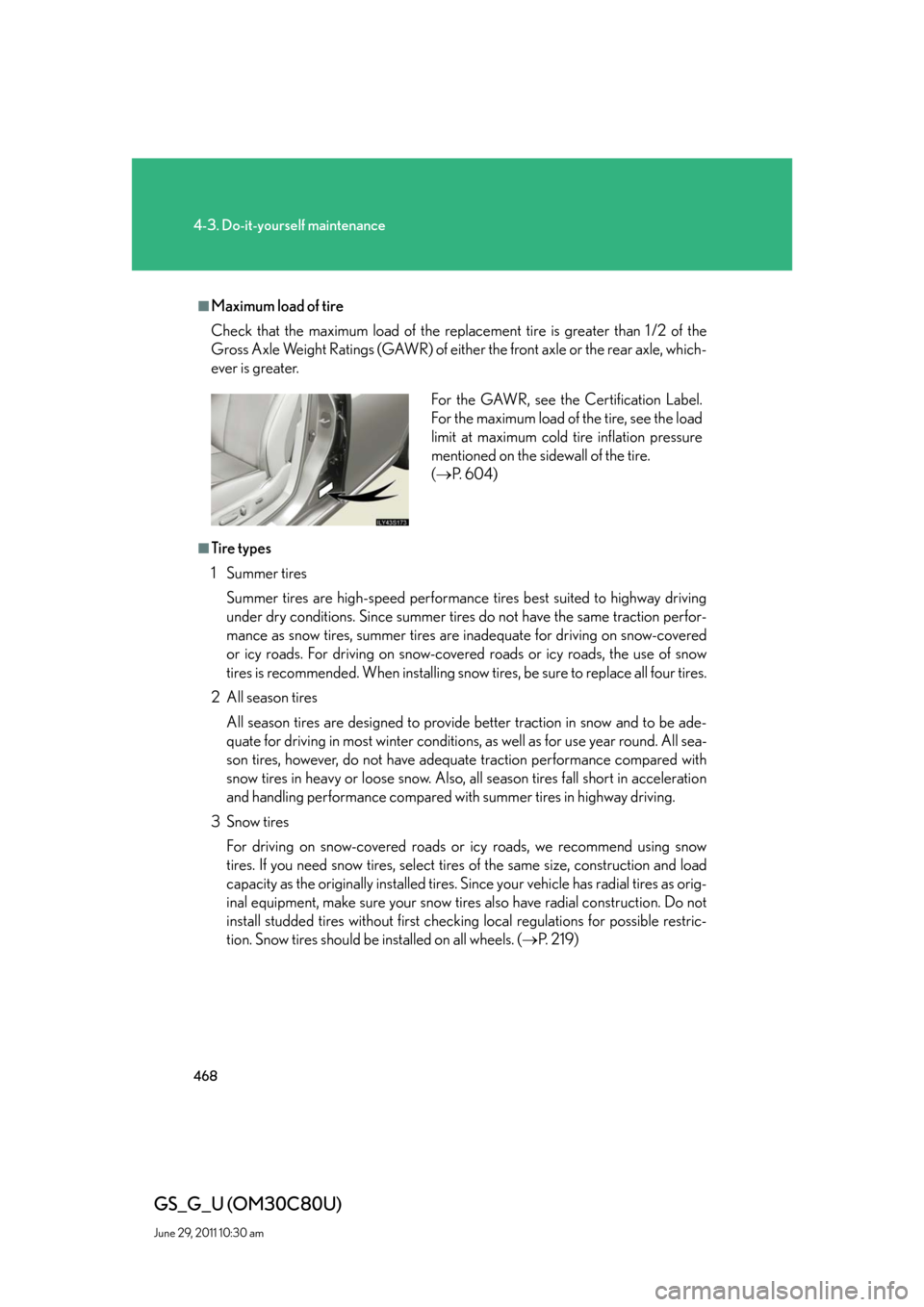
468
4-3. Do-it-yourself maintenance
GS_G_U (OM30C80U)
June 29, 2011 10:30 am
■Maximum load of tire
Check that the maximum load of the replacement tire is greater than 1 /2 of the
Gross Axle Weight Ratings (GAWR) of either the front axle or the rear axle, which-
ever is greater.
■Tire types
1 Summer tires
Summer tires are high-speed performance tires best suited to highway driving
under dry conditions. Since summer tires do not have the same traction perfor-
mance as snow tires, summer tires are inadequate for driving on snow-covered
or icy roads. For driving on snow-covered roads or icy roads, the use of snow
tires is recommended. When installing snow tires, be sure to replace all four tires.
2All season tires
All season tires are designed to provide better traction in snow and to be ade-
quate for driving in most winter conditions, as well as for use year round. All sea-
son tires, however, do not have adequate traction performance compared with
snow tires in heavy or loose snow. Also, all season tires fall short in acceleration
and handling performance compared with summer tires in highway driving.
3Snow tires
For driving on snow-covered roads or icy roads, we recommend using snow
tires. If you need snow tires, select tires of the same size, construction and load
capacity as the originally installed tires. Since your vehicle has radial tires as orig-
inal equipment, make sure your snow tires also have radial construction. Do not
install studded tires without first checking local regulations for possible restric-
tion. Snow tires should be installed on all wheels. (P. 2 1 9 )
For the GAWR, see the Certification Label.
For the maximum load of the tire, see the load
limit at maximum cold tire inflation pressure
mentioned on the sidewall of the tire.
(P. 6 0 4 )